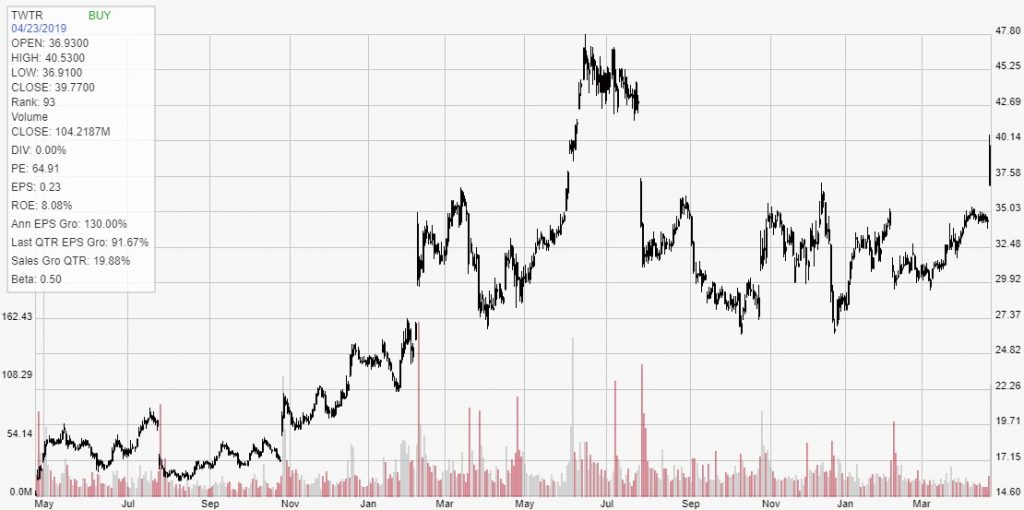After a mixed Q4 2018 marked by a strong decline in monthly active users (MAUs), Twitter Inc. (TWTR) reported a strong rebound in Q1, giving investors enough reason to push shares to their highest level in over nine months on Tuesday. The earnings made TWTR by far the S&P 500’s biggest gainer and kicked the newest round of Big Tech earnings off on a strong note.
But Twitter still has a long way to go in terms of handling the rampant harassment the platform has become known for in recent years. While CEO Jack Dorsey’s efforts to improve the social media service played a big role in Tuesday’s earnings success, investors may be eager to see if more improvements that can keep pushing shares higher are on the way.
Here’s a closer look at Twitter’s latest round of financials – and what they say not just about how far the firm has come but also about how far it still has to go in the future…
The News
Twitter demolished analyst expectations on the top and bottom lines, with MAUs – the metric that dragged shares nearly 10% lower following the previous earnings report – also showing signs of strength.
The firm posted earnings per share (EPS) of $0.37, which not only more than doubled the year-ago EPS of $0.16 but also surpassed the estimated $0.15 by a staggering 147%. Revenue also soared past Wall Street estimates, coming in 1.4% above the $776.1 million prediction at $787 million during the January-March period.
This quarter is unique for Twitter in that it will be the last one for which the firm reports MAUs, announcing the decision in February amid a wave of similar changes from Apple Inc. (AAPL) and Facebook Inc. (FB). Twitter had 330 million MAUs in the first quarter, surpassing the expected 318 million by 3.8%. Monetizable daily active users (mDAUs) – which will replace the MAU metric and include “Twitter users who log in and access Twitter on any given day through Twitter.com or our Twitter applications that are able to show ads,” according to the company – came in at 134 million, up from 120 million in the year-ago period and 126 million in Q4 2018.
How Investors Reacted
Investors were thrilled by Twitter’s strong profit and MAU growth, pushing shares up 15.6% from $34.39 to $39.77 on Thursday. That was TWTR’s best close since July 26, 2018 when shares settled at $42.94 in the midst of a nosedive that bottomed at $31.38 on July 30. Taking into account Thursday’s closing price, shares are up 38.4% year-to-date from the Dec. 31 close of $28.74.
Twitter dominated the S&P 500, which itself earned a record close thanks not just to Twitter but also to an array of massive gainers. Right behind Twitter was Hasbro Inc. (HAS), the world’s largest toymaker whose shares vaulted more than 14% on the day. Rounding out the top five were Kohls Corp. (KSS), Quest Diagnostics Inc. (DGX), and Celanese Corp. (CE), which respectively climbed 11.9%, 9.3%, and 7.4%.
The Bigger Picture
Despite the consistently poor public perception of the platform as a haven for abuse and controversial opinions, Twitter’s community continues to grow in spades, and it’s largely a result of the company’s own initiatives to tweak the platform in various ways.
The site was originally viewed as an outlet for positive change, particularly during the heyday of the Arab Spring when users coordinated to organize protests that eventually led to several leaders being ousted in favor of democratic change. Recently, however, it’s been seen as an outlet for negativity, which Dorsey has attempted to remedy by banning controversial users and conspiracy theorists like Alex Jones that use the platform to push far-right or racist ideas. In Tuesday’s call with analysts, Dorsey noted he’s trying to take “a bunch of the burden away from the victims of abuse and harassment on our service” by making his own company “much more effective and much more efficient.”
By the end of last year, Twitter had suspended as many as 70 million accounts linked to hate speech or generally suspicious behavior. Now, Twitter is enhancing that initiative by employing machine-learning algorithms to pore through tweets and proactively send suspicious items to the appropriate teams for review. According to the company, these algorithms are responsible for roughly 38% of the abusive content that’s taken down.
However, the continuation of these methods, while aiming to promote a positive platform experience, may reverse the strong user numbers that investors embraced on Thursday. It’s clear the 70 million banned accounts were responsible for the precipitous decline in MAUs in Q4, which subsequently led to a sharp drop in share price. Some analysts believe the user experience to be more important, with R.W. Baird analyst Colin Sebastian saying Dorsey’s initiatives will keep fueling daily active users, which “is the best leading indicator for the health of the platform.”
Looking Ahead
Once the confetti from Thursday’s incredible earnings settles, investors will undoubtedly remember that Twitter remains in an exceptionally tough spot. As arguably the world’s most influential platform for opinions, Twitter has to struggle with both its heft as a cultural tool and its heft as a major player in the tech market. Whether or not investors can embrace quality of the service over growth of the service is something that remains to be seen.
As for investors considering buying into TWTR, it might be best to wait for a dip in share price. With the stock currently hovering near nine-month highs, market participants should carefully consider the stock’s volatile nature before making an entrance.
